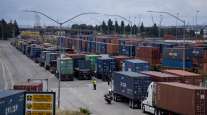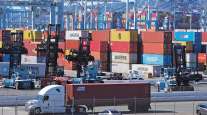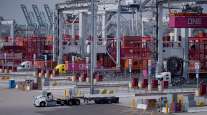Senior Reporter
Ports Close Out Year of Change; Infrastructure on Tap in 2023

[Stay on top of transportation news: Get TTNews in your inbox.]
As 2022 comes to a close, a significant shift is taking place at America’s ports. Until late summer, Los Angeles’ was the busiest in the nation, but that honor now belongs to the Port Authority of New York and New Jersey.
Port of Los Angeles Executive Director Gene Seroka said he is working to persuade shippers to bring cargo back to his facility, and the adjacent Port of Long Beach. Together, they processed more than 20 million 20-foot-equivalent containers.
But Los Angeles’ TEU volume is down 6% from last year’s all-time record, and November was a bad month.
Cargo volume remained soft at the Port of Los Angeles in November as the Port handled 639,344 TEUs, a 21% decrease from November 2021. Overall, the #PortofLA has handled 7% less cargo in the first 11 months of 2022 compared to last year’s all-time record. https://t.co/EQNggKdDK9 pic.twitter.com/z8bZSD3n7C — Port of Los Angeles (@PortofLA) December 15, 2022
“We’ve had a 25% drop [in October], which means we’ve got 25% more capacity here in Los Angeles,” Seroka said. “While the other ports are unfortunately struggling, we can pick up the slack. We’ve got to get these retailers, importers, exporters to understand they have a viable alternative at Los Angeles.”
While Los Angeles is down, the nearby Port of Long Beach is ending 2022 holding its own. Through early November, the port was up 1.5% year-over-year, moving more than 8 million TEUs during the first 10 months.
“Over the long term, the San Pedro Bay ports complex will continue to be a competitive, strategic and sustainable gateway for transpacific trade,” Port of Long Beach Executive Director Mario Cordero said.
The busiest port in America is no longer on the West Coast and hasn't been for the last three months. Find is which US port is cargo king and why: https://t.co/3WFS4pH4AG — Vanessa Yurkevich (@VanessaCNN) December 9, 2022
As the year comes to close, and with December cargo numbers not expected until mid-January, several East Coast ports — including Savannah, Ga.; Charleston, S.C.; the Port of Virginia and New York-New Jersey — are seeing record or near-record container volume.
Also, Port Houston already was in record territory, and the numbers from the final month of the year are expected to easily put the facility over the top. Houston’s container volume is up 18% year-to-date, and the port has surpassed the 3 million mark thus far, with 3,333,924 TEUs.
We are handling record amounts of cargo and remain focused on aggressive infrastructure development.
Port Houston Executive Director Roger Guenther
Image
“Although the import demand in the U.S. appears to be softening, we have not seen any slowing in Houston in recent months,” Port Houston Executive Director Roger Guenther said. “We are handling record amounts of cargo and remain focused on aggressive infrastructure development to optimize capacity and efficiently handle current and future demand through our port.”
Experts say the trend is likely to continue, especially as those ports now receiving more cargo fight to keep those ships coming to their facilities.

Wooten
“There has been downward pressure on the total U.S. container trade related to inflation and a shift in consumer spending toward services such as restaurants and travel,” Georgia Ports Authority Chairman Joel Wooten Jr. said. “However, the Port of Savannah continues to outperform relative to the national market, driving new business for Georgia.”
The Port of Savannah also is a success story on the East Coast, and volume at the facility is expected to soar in the coming years. That’s due in part to a multimillion-dollar expansion plan and the recent announcement that 60 miles away, vehicle maker Hyundai is building a nearly $6 billion electric car and truck manufacturing plant. It is expected that Port of Savannah will be a key player in exporting vehicles and importing components.

Seroka
Some of the decline on the West Coast, Seroka said, is because of concern over labor negotiations between the Pacific Maritime Association and the International Longshore and Warehouse Union. Twenty-nine facilities, 70 companies and more than 22,000 union members are affected.
Dockworkers have worked without a union contract since July 1, and little progress has been made on a new deal. Negotiations resumed after Thanksgiving, and both sides have vowed to talk until a new pact is reached. Both sides pledged there would be no labor disruption, either by a strike or lockout.
“It’s really disappointing to me, because the first time in all the years I’ve been in this industry that both sides put out two joint media releases signed by both that said we will not lock out and the labor guys said we will not go out on strike,” Seroka said.
In economic terms, a complete shutdown of the ports of Los Angeles and Long Beach alone could cost the U.S. economy about $500 million a day in lost trade, according to the National Association of Manufacturers.
The Long Beach International Gateway Bridge was honored on Nov. 28 for contributing to the national economy as a vital link in the global supply chain by three leading organizations representing designers and public operators of U.S. infrastructure. pic.twitter.com/tCmbFJCAJA — Port of Long Beach (@portoflongbeach) December 12, 2022
While freight is shifting from one coast to another, the nation’s ports are set to receive an influx of local, state and federal money that could reach more than $25 billion over the next five years once all the spending is accounted for.
The federal government is providing the majority of the money, an estimated $17.4 million under the Infrastructure Investment and Jobs Act. Billions more are expected to be available from states and private sector investment.

Connor
“Let’s face it, the COVID-19 crisis brought unprecedented attention to ports,” Chris Connor, CEO of American Association of Port Authorities, told attendees at the annual conference. “As a result, we are in the early stages of a generational opportunity to build out port and intermodal connectivity that is more efficient, resilient and cleaner than ever before.”
Much of the money will be used for dredging shipping channels, purchasing more cranes, improving highway and road access for truck drivers and expanding intermodal rail.
Not all the port expansion is about adding new equipment at existing facilities. New ports are either under construction or in advanced planning stages.
Inland ports are now operating and will be expanded in Salt Lake City, and south of Dallas, while another is in development in Gainesville, Ga. Others are being planned in Plaquemines Parish, La., and Cairo, Ill., along the confluence of the Mississippi and Ohio rivers.
A year ago, more than 100 ships waited their turn amid supply chain bottlenecks triggered by the pandemic. Not anymore, thanks to hard work by transportation workers, key businesses, and this Administration. — Secretary Pete Buttigieg (@SecretaryPete) December 11, 2022
To highlight the importance of ports, several Cabinet members and other officials, including Transportation Secretary Pete Buttigieg, Labor Secretary Marty Walsh and Supply Chain Envoy Stephen Lyons, have made numerous visits to complexes to discuss ways to solve supply chain problems.
Lyons was the keynote speaker at AAPA’s annual conference. He said he believes the overall health of the U.S. economy depends on how the ports are doing.
“There is never a time that’s been more important for this association to come together and unify the effort of what the future should look like, and what essentially equates to American prosperity,” Lyons said.

“The term ‘supply chain,’ you hear a lot about that now,” said Sean Strawbridge, the new AAPA chairman and CEO of Port of Corpus Christi. “You know, you go to the store and they all have something to say. ‘What are they going to do to fix the supply chain?’ ”
One major port is pursing a plan to expand on two fronts. In 2020, the Port of Oakland dealt with a series of setbacks as it saw container volumes plunge as a result of the soaring rates. At one time, shippers were getting more than $16,000 a container compared with $2,500 before the pandemic.

Wan
Instead of making Oakland its second or third stop on the Pacific route, ships headed back to China and other Asian nations with empty containers because it was significantly more profitable to return to the U.S. fully loaded than make a 400-mile trip north to the Bay Area. Much of the cargo that was unloaded at Los Angeles and Long Beach was then sent to Oakland by truck.
“Some of the shipping carriers have been skipping Oakland because they want to hurry back to Asia and pick up some more valuable imports that they’re getting a premium price on,” Port Executive Director Danny Wan said.
The Bay Area port responded with several big projects. Among them is emphasizing agriculture exports since the port has a direct BNSF rail line connecting the facility as far east as Chicago and running through several key Midwest states, including Iowa and Nebraska. Union Pacific also operates an extensive intermodal terminal there.
Our City will continue to work closely with the @Athletics on a shared vision + timeline to bring a responsible deal for a new, iconic ballpark district to the City Council for a vote this year. #DrumTogether — Libby Schaaf (@LibbySchaaf) July 19, 2022
In 2023, the Northern California facility may be undergoing more significant change, if the City of Oakland, the Oakland Athletics and Major League Baseball can come to terms on a new stadium. The city, port and team are still negotiating a possible $12 billion deal to construct a ballpark and real estate development at the port at an abandoned terminal site. The proposal is far from a done deal, and MLB officials said at the recently completed Winter Meetings that they are discouraged by the pace of talks.
However, several members of the Oakland City Council and Wan believe the stadium will receive local approval.
“We have a great plan for making sure that that development is compatible with the maritime uses, as well as the baseball park,” Wan said. “And by the way, there are plans for 3,000 units of housing on that site.”
MLB has given the City of Oakland a deadline to get the project on track by early 2023 or the Athletics will consider relocating, possibly to Las Vegas. In 2020, the NFL’s Raiders abandoned aging RingCentral Coliseum — home of the A’s — for the Las Vegas Strip.
Stay tuned. 2023 already is promising to be a most interesting year at the nation’s ports.
Want more news? Listen to today's daily briefing below or go here for more info:





